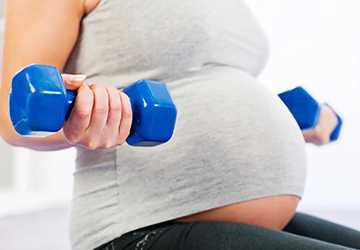How to Stay Active During Pregnancy
There is a need to maintain good health throughout pregnancy.
Physical activity during pregnancy is essential for the health of the mother and fetus. Regular physical activity can help reduce excess weight gain, improve sleep quality, relieve pregnancy symptoms, and prepare the body for childbirth. Carefully following pregnancy exercise tips can go a long way toward maintaining optimal health during these critical months.

How to stay active during pregnancy
Starting a fitness routine during pregnancy may seem complicated, but there are a variety of safe and enjoyable alternatives to stay physically active during this stage:
●Walking: This simple and accessible form of exercise is still suitable for all stages of pregnancy.
●Water activities: These are shown to have minimal impact on the joints and muscular system, making them ideal for expectant mothers.
●Prenatal Yoga: This program focuses on specific stretches, mental focus, and conscious breathing techniques to help cope with labour.
Best Practices for Pregnancy and Fitness
While the benefits of prenatal exercise are many, following established safety protocols is critical to the health of both mother and fetus:
●Medical Advice: Essential before starting a new exercise routine.
●Hydration is vital: Maintaining high hydration levels is crucial, especially on physically active days.
●Follow physiological instructions: It is essential to avoid overexertion and stop all activities that cause discomfort or pain.
Pregnancy exercise tips tailored for each trimester.
first three months
●Stability Center: Maintaining balance becomes increasingly tricky as physiological changes begin. Stationary cycling or restorative yoga can have significant benefits.
●Adjust energy levels: Adjusting exercise intensity early in pregnancy to accommodate natural energy fluctuations is crucial.
second trimester
● Core Strengthening: Exercises that strengthen the core muscles can help the spine expand the abdomen.
●Moderate resistance training: Mild resistance helps maintain muscle integrity and strength, which is crucial in preparation for childbirth.
late pregnancy
●Pelvic floor strengthening: These exercises are becoming increasingly important because they strengthen the organs that withstand the increased pressure on the uterus.
●Flexibility maintenance: Flexibility can relieve discomfort during late pregnancy and prepare the body for delivery.
Develop an effective training plan.
Developing a fitness plan should include a combination of fun and varied activities. This approach ensures compliance and increases variety and engagement in daily work. Here are some insights into building a balanced exercise framework:
●Consistency and intensity: Prioritize regular, moderate activity over intermittent, high-intensity activity.
●Plan the recovery period: To meet the physiological needs during pregnancy, giving time to recover.
●Ad is critical. Modifications: Depending on how your pregnancy progresses, you must be prepared to adapt your exercise program to your changing physical limitations.
Promote cardiovascular health during pregnancy.
Implement an intermittent walking program.
Structured interval walking is characterized by alternating fast and slow walking, which can effectively enhance cardiovascular endurance without putting undue stress on the body of expectant mothers. This technology optimizes circulatory efficiency and helps regulate arterial pressure, critical during pregnancy.
Introduce low-impact aerobic exercise.
Low-impact prenatal aerobic exercise focused on maternal health keeps heart rate within safe parameters while promoting a social and collaborative atmosphere of physical activity. These classes build cardiovascular stability and are designed to reduce stress on your joints and pelvic floor.

Improve musculoskeletal integrity.
Attend Customized Pilates
Prenatal Pilates offers a unique way to strengthen core, back, and pelvic muscles to support the body in coping with the physical demands of pregnancy. Pilates can increase body awareness, improve posture, and relieve back pain through careful, calibrated movements.
Use a stability ball.
Using a stability ball in your exercise program can help maintain balance and core strength as your centre of gravity grows during pregnancy. These plans typically include seated and upright positions and can be adjusted for safety and comfort throughout pregnancy.
Promote mental and emotional health.
Comprehensive guided relaxation techniques
Using guided meditation and relaxation methods can significantly reduce stress and positively impact the health of both mother and child. Modalities such as guided visualization and progressive muscle relaxation are seamlessly integrated into daily life to promote mental calm.
Attend a supportive group class.
Attending prenatal fitness classes can provide necessary social support and reduce feelings of isolation by encouraging connections with peers with similar maternal experiences. These gatherings offer emotional enrichment and a shared forum for illuminating health and wellness issues during pregnancy.
Promotes flexibility and smooth movement.
Incorporate gentle stretching exercises.
Daily gentle stretching will gradually increase flexibility, relieve muscle tension, and improve range of motion, which is especially beneficial for the continued development of pregnant women's bodies. A stretching regimen may include dynamic stretching for physical activation and static stretching for stress reduction.
Practice dance-based fitness.
Pregnancy-friendly dance fitness programs offer a fascinating way to stay active. These programs emphasize gentle movement, rhythm, and musical elements, providing cardiovascular benefits and mood enhancement without the intense impact typical of traditional dance exercises.
Biofeedback training reduces stress.
Biofeedback sessions tailored for pregnant women can help them understand and control various physiological responses to stress. Using sensors that measure body functions such as heart rate and muscle tone, expectant mothers can learn to regulate their stress response to improve their emotional and physical health.
Cognitive Behavioral Strategies for Emotional Health
Using cognitive behavioural strategies during pregnancy can help manage mood changes and stress. Techniques such as mindfulness, positive imagery, and rational emotive behaviour therapy are adapted to the needs of pregnant women, providing them with tools to increase emotional stability and resilience.
Promotes joint health and energy conservation.
Energy Optimizing Workout
These exercises maximize energy use and keep you healthy without depleting the mother's energy reserves. Exercises are chosen to effectively promote cardiovascular fitness, muscle strength and minimal energy expenditure to ensure the expectant mother remains active and energetic.
Union-friendly training program
Unique exercise routines that focus on protecting and strengthening joints can help counteract the laxity caused by pregnancy hormones. Low-impact exercise, including gentle stretching, strength, and posture training, is critical to preventing discomfort and improving mobility during pregnancy.
Conclusion
By following these pregnancy exercise tips, expectant mothers can stay fit, promote a healthier pregnancy, and potentially have a smoother delivery. Whether it's pregnancy yoga, water aerobics or regular walks – the fundamental principle of pregnancy and fitness is to stay active enjoyably and sustainably. Tailoring a fitness plan to individual health needs and specific pregnancy conditions is critical, considering each woman's different pregnancy experience.